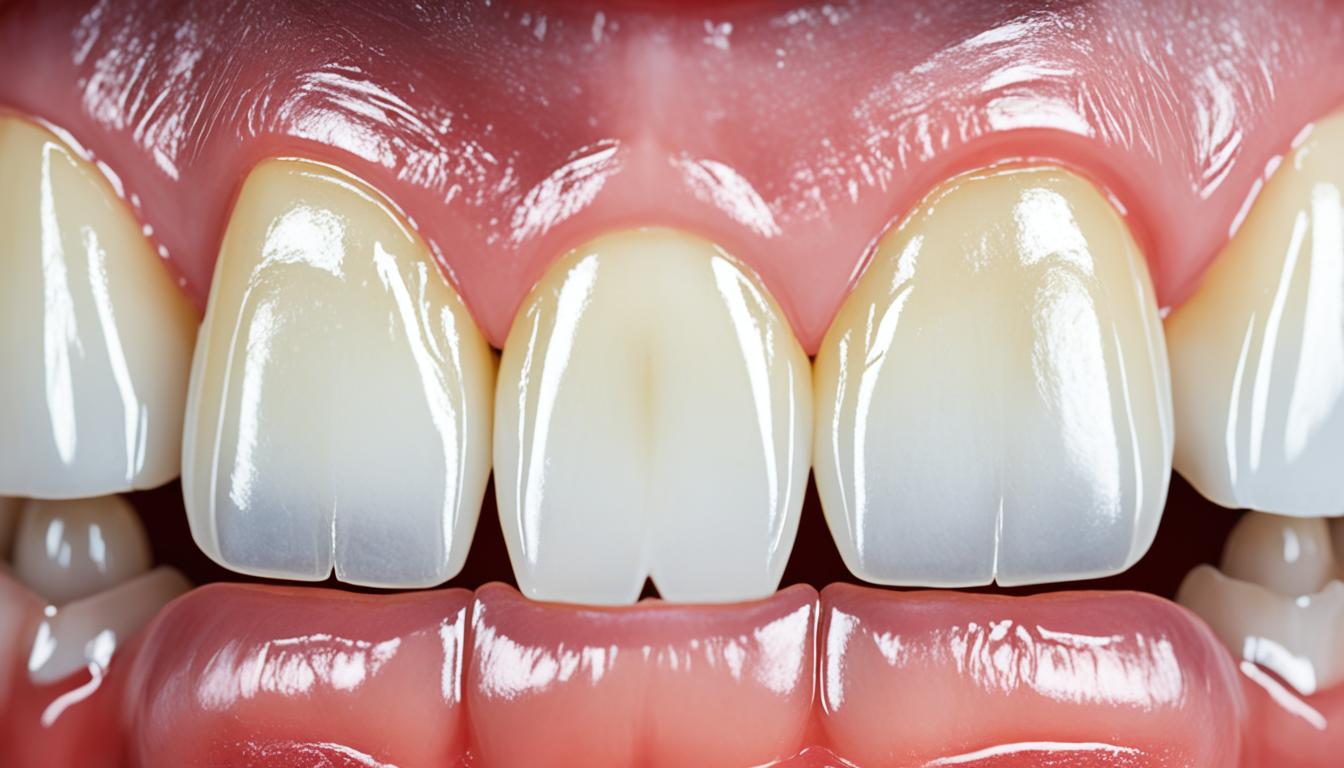Teens’ Dental Count: How Many Teeth Do Teens Have?
As teenagers navigate through their adolescent years, it’s important to pay attention to their dental development and oral health. One key aspect to consider is the number of teeth teens have and how they change as they grow. Understanding the teenage teeth count can help parents and teens alike maintain proper dental care and ensure a healthy smile.
Key Takeaways:
- Teens typically have 32 permanent teeth, including incisors, canines, premolars, and molars.
- Proper dental hygiene and regular visits to a pediatric dentist are essential for maintaining dental health in teens.
- Teeth development in children starts with the eruption of baby teeth and continues until the late teens or early twenties.
- Wisdom teeth, or third molars, commonly erupt during the late teenage years or early twenties and may require removal if impacted.
- Understanding tooth anatomy and the functions of different teeth can help promote overall oral health.
Dental Development in Children
Proper dental development is crucial during a teen’s formative years. Understanding the process of tooth eruption and growth in adolescents allows parents and caregivers to monitor their child’s dental health effectively. Let’s explore the stages of dental development in children and the transition to permanent teeth.
Stage 1: Baby Teeth Eruption
Dental development begins in infancy when baby teeth, also known as primary teeth, start to erupt around 6 months of age. By the age of three, children typically have all 20 primary teeth in place. These primary teeth serve as placeholders for the permanent teeth that will eventually replace them.
Stage 2: Transition to Permanent Teeth
As children grow into their teenage years, their baby teeth will naturally start to fall out. This process, known as exfoliation, allows room for the permanent teeth to erupt. The eruption of permanent teeth usually begins around the age of 6 and continues until late teens or early twenties. Most teenagers will have 28 permanent teeth by age 13, with the remaining 4 wisdom teeth (third molars) erupting later on.
During this stage, it is common for teenagers to experience temporary gaps or uneven tooth alignment as the permanent teeth gradually take their place. This is a normal part of dental development and should not be a cause for concern. However, if there are significant delays or abnormalities in tooth eruption, it is recommended to seek professional dental care for evaluation.
Monitoring Dental Development
Parents and caregivers play a vital role in monitoring their teen’s dental development. Regular dental check-ups are essential to ensure that the transition from baby teeth to permanent teeth is occurring as expected. A pediatric dentist can assess the eruption pattern, identify any abnormalities or delays, and provide appropriate guidance or treatment if needed.
Taking Care of Teenage Teeth
During this critical period of dental development, proper oral hygiene is essential for teens. Encourage them to brush their teeth at least twice a day for two minutes using fluoride toothpaste. Additionally, daily flossing helps remove plaque and food particles from between teeth.
It is also crucial for teenagers to maintain a balanced diet rich in vitamins and minerals, as proper nutrition supports healthy tooth development. Limiting consumption of sugary foods and drinks is important in preventing tooth decay and maintaining overall oral health.
How Many Baby Teeth Do Kids Have?
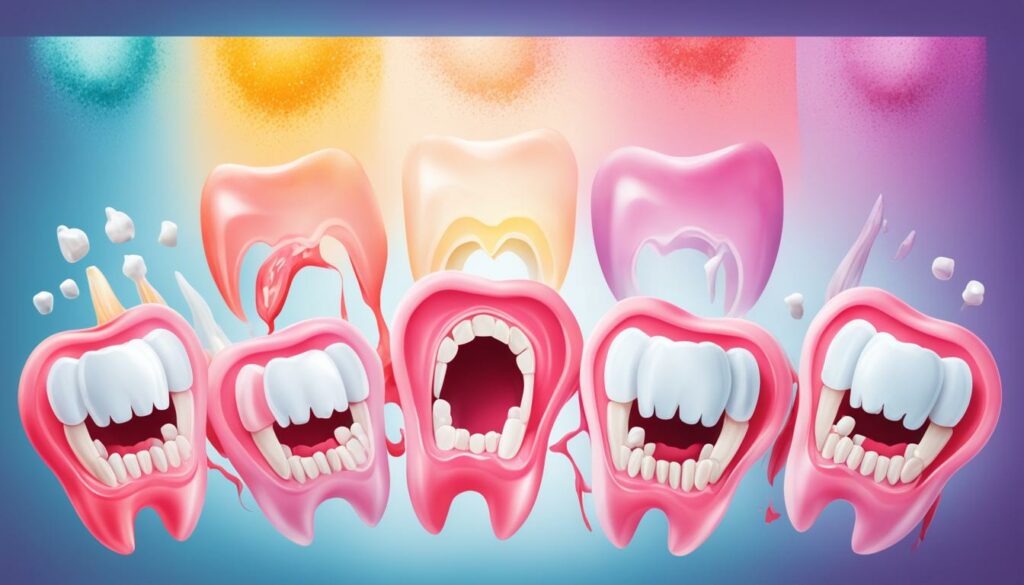
Kids have a total of 20 baby teeth, also known as primary teeth. These include 8 incisors, 4 canines, and 8 molars. The order in which baby teeth erupt can vary slightly from child to child, but most children will have all their baby teeth by age three.
This age-related tooth development is an exciting time for young children as they begin to explore their world and develop essential oral health habits. The eruption of baby teeth marks a significant milestone in their dental journey, setting the stage for a lifetime of healthy smiles.
Here is a breakdown of the different types of baby teeth and their functions:
Incisors
Incisors are the eight front teeth, four on the upper jaw and four on the lower jaw. They are the first to erupt, usually around 6-10 months of age. Incisors play a crucial role in biting and cutting food.
Canines
The four canines, also known as “eye teeth” or “cuspid teeth,” are the next to appear, typically between 16-20 months of age. Canines have a pointed shape and are used for tearing and holding food.
Molars
The final set of baby teeth to erupt are the molars, with eight in total. The first molars emerge between 12-16 months, followed by the second molars between 20-30 months. Molars are larger, flatter teeth designed for grinding and chewing food.
Understanding the baby teeth count and their sequence of eruption is essential for parents to monitor their child’s dental development. Regular visits to a pediatric dentist can provide guidance and ensure that any potential issues are addressed promptly.
When Do Kids Get Their Permanent Teeth?
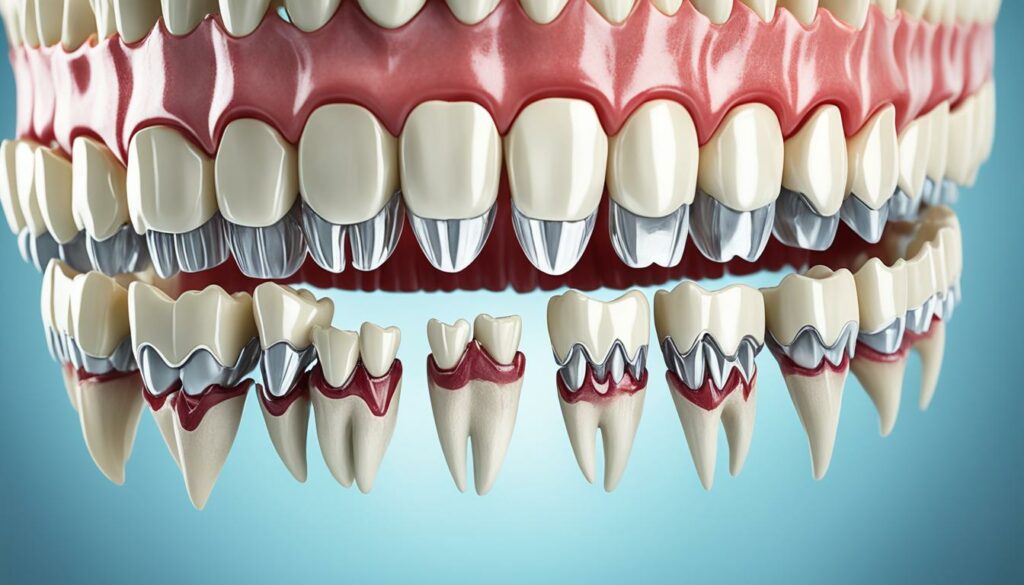
Kids begin to get their permanent teeth around the age of 6 and the process continues until their late teens or early twenties. This period of permanent teeth eruption is considered a significant dental milestone in teenage and young adult dental health. By the age of 13, most children will have 28 permanent teeth, with the remaining 4 wisdom teeth (third molars) erupting later in life. It is important to note that not everyone’s wisdom teeth will fully erupt.
By the time a child reaches the age of 25, they should have all 32 permanent teeth. The eruption of these permanent teeth marks a crucial phase in dental development and signifies the transition to young adulthood.
To provide a clearer overview of permanent teeth eruption, the following table highlights the average eruption timeline for different types of permanent teeth:
| Tooth Type | Average Eruption Age |
|---|---|
| Central incisor | 6-7 years |
| Lateral incisor | 7-8 years |
| First premolar | 10-12 years |
| Second premolar | 11-12 years |
| Canine | 11-12 years |
| First molar | 6-7 years |
| Second molar | 12-13 years |
| Third molar (wisdom tooth) | Late teens to early twenties |
It is important for parents and young adults to be aware of the permanent teeth eruption timeline to ensure proper dental care and monitor any potential issues. Regular dental check-ups and good oral hygiene practices are essential during this period to maintain optimal dental health.
Understanding Tooth Anatomy
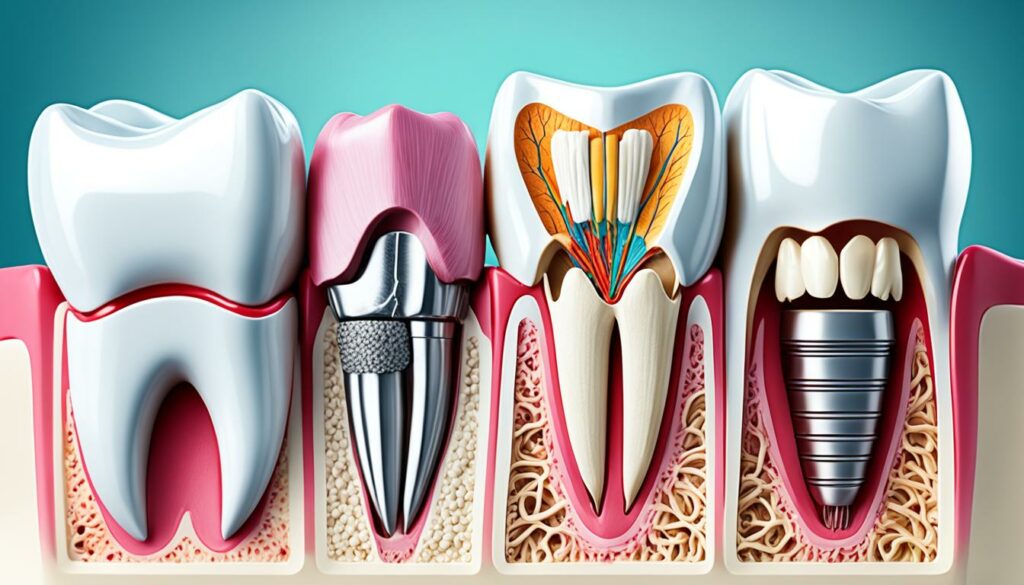
The anatomy of teeth is a fascinating subject that plays a crucial role in maintaining proper dental care. Each tooth is composed of three layers: enamel, dentin, and pulp. Let’s explore the structure and function of these tooth layers.
Tooth Layers:
- Enamel: The outermost layer of the tooth is called enamel. It is the hardest tissue in the human body and protects the underlying layers from decay and damage.
- Dentin: Beneath the enamel lies the dentin, a yellowish substance that makes up most of the tooth structure. Dentin contains tiny tubes called dentinal tubules, which connect to the pulp.
- Pulp: The innermost layer of the tooth is the pulp. It contains nerves, blood vessels, and connective tissue. The pulp plays a vital role in tooth development and sensory perception.
Understanding the dental anatomy and tooth structure is essential for maintaining good oral health. Now, let’s take a closer look at each layer.
Enamel: The Protective Shield
The enamel is a remarkable layer that safeguards the tooth from the daily wear and tear of chewing, biting, and grinding. It is highly mineralized, consisting mainly of hydroxyapatite crystals that give it its strength.
Although enamel is incredibly sturdy, it can still be damaged by acids produced by bacteria, acidic foods, and poor oral hygiene. Maintaining a balanced diet, practicing regular brushing and flossing, and limiting sugary and acidic food and drinks can help protect enamel from erosion.
Dentin: The Supportive Layer
Beneath the enamel lies the dentin, a softer layer that makes up the bulk of the tooth structure. It is composed of tiny tubules that contain nerve endings and extend towards the pulp. Dentin provides support to the enamel and helps transmit sensations like temperature and pressure to the nerves in the pulp.
When the enamel wears down or gets eroded, dentin can become exposed, leading to sensitivity and discomfort. Maintaining good oral hygiene habits and seeking professional dental care can help prevent dentin-related issues.
Pulp: The Vital Core
The pulp is the innermost layer of the tooth that houses blood vessels, nerves, and connective tissue. It is responsible for nourishing the tooth during development and providing sensory perception.
If the enamel and dentin become compromised through dental decay or injury, bacteria can reach the pulp, leading to infection and inflammation. In such cases, root canal therapy may be necessary to remove the infected pulp and save the tooth.
Did you know? The pulp contains specialized cells called odontoblasts that produce dentin throughout our lives. These cells help repair and maintain the tooth’s structure.
Understanding the intricate tooth anatomy is essential for maintaining proper dental care. By taking care of the outermost enamel layer, supporting dentin, and the vital pulp, we can ensure the longevity and health of our teeth.
Functions of Different Teeth
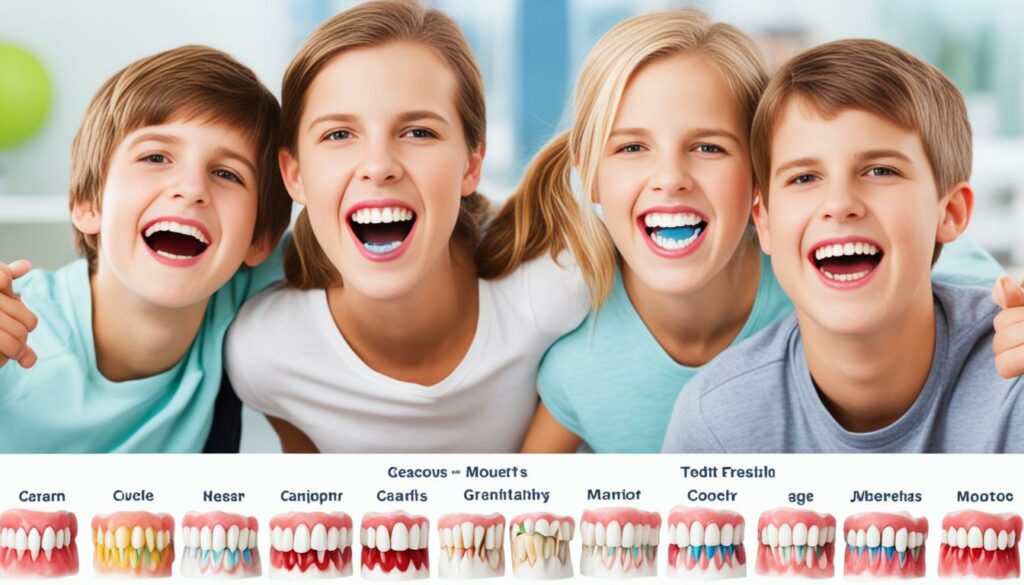
Different types of teeth have specific functions in the chewing and eating process. Understanding the roles of each type of tooth is crucial for maintaining optimal oral health and proper food processing.
Incisors
Incisors are the front teeth located in the mouth’s central area. They have a thin, sharp edge and are primarily used for cutting food into bite-sized pieces. Incisors enable us to bite into and chew food effectively.
Canines
Canines, also known as cuspids, are the pointed teeth located on either side of the incisors. With their long and sharp shape, canines are designed for tearing and gripping food. They play a crucial role in biting into tougher or larger food items, such as meat.
Premolars
The premolars, or bicuspids, are located behind the canines. They have a flat surface with ridges that enable grinding and crushing food. Premolars are essential for preparing food for further digestion, breaking it down into smaller particles.
Molars
Last but not least, the molars are the largest and strongest teeth located at the back of the mouth. With their large, broad surfaces covered in ridges and cusps, molars are designed for tearing, grinding, and chewing food thoroughly. They are responsible for further breaking down the food particles and ensuring efficient digestion.
To summarize, incisors cut food, canines tear food, premolars crush and grind food, and molars tear and chew food. Each type of tooth has a specific function that contributes to the overall oral health and effective food processing.
Note: The image above depicts the different types of teeth and their functions.
Dental Care for Teens

Dental care plays a crucial role in teenagers’ overall health and well-being. By practicing good oral hygiene habits and scheduling regular dental check-ups, teens can maintain healthy teeth and gums for a lifetime.
Tips for Teen Dental Care
- Brush your teeth at least twice a day for two minutes using a fluoride toothpaste. Make sure to clean all surfaces of your teeth, including the front, back, and chewing surfaces.
- Floss your teeth daily to remove plaque and food particles from between your teeth where a toothbrush can’t reach.
- Avoid excessive consumption of sugary foods and drinks, as they can increase the risk of tooth decay. Opt for healthier snacks and drinks, such as fruits, vegetables, and water.
- Wear a mouthguard when participating in sports or recreational activities to protect your teeth from injuries.
It’s important to understand that proper dental care extends beyond brushing and flossing. Regular dental check-ups are essential for maintaining good oral health. They allow your dentist to identify any dental issues at their early stages and provide necessary preventive treatments.
The Importance of Regular Dental Check-ups
“Regular dental check-ups help ensure that any potential dental problems are detected and treated early, preventing further complications. They also offer an opportunity for professional cleaning, which removes plaque and tartar buildup.” – Dr. Emily Miller, Pediatric Dentist
Your dentist will examine your teeth and gums, look for signs of cavities or gum disease, and perform professional cleaning to remove plaque and tartar. They may also provide dental treatments such as fluoride application to strengthen your teeth and dental sealants to protect against cavities.
Recommended Dental Check-up Frequency
| Age Group | Recommended Dental Check-up Frequency |
|---|---|
| 12-19 years | Every 6 months |
It’s crucial for teenagers to understand that dental check-ups are not just for addressing existing problems. They are essential for preventive care, ensuring healthy teeth and gums throughout adolescence and into adulthood.
By prioritizing dental care and adopting a proactive approach to oral hygiene, teens can enjoy a bright and healthy smile that lasts a lifetime.
Eruption of Wisdom Teeth
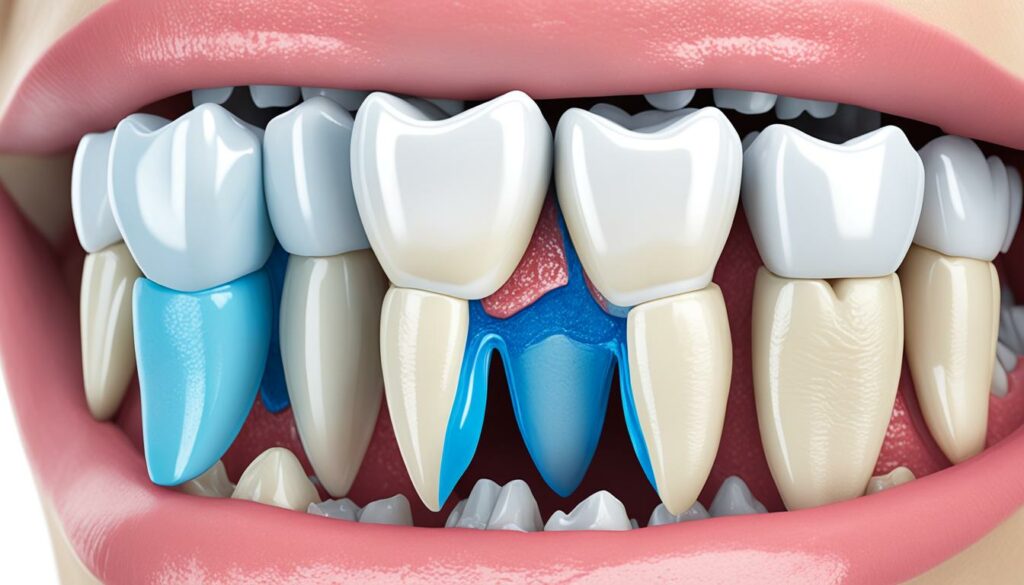
Wisdom teeth, also known as third molars, are the last set of teeth to develop in the mouth. They typically erupt in the late teens to early twenties, long after the rest of the permanent teeth have come in. However, not everyone experiences the eruption of wisdom teeth, and many individuals may encounter a common dental issue known as impacted wisdom teeth.
Impacted wisdom teeth occur when there is not enough space in the jaw for these teeth to fully emerge. As a result, they can grow at an angle or get trapped beneath the gumline. This condition can cause various problems, including:
- Pain and discomfort
- Infection
- Damage to surrounding teeth
In such cases, wisdom teeth removal may be necessary to alleviate the pain and prevent further complications. This procedure is typically performed by an oral surgeon or a dentist with advanced training in oral surgery.
“Impacted wisdom teeth can cause pain and potential damage to surrounding teeth. Wisdom teeth removal may be recommended to address these issues.”
Dental Anomalies and Variations
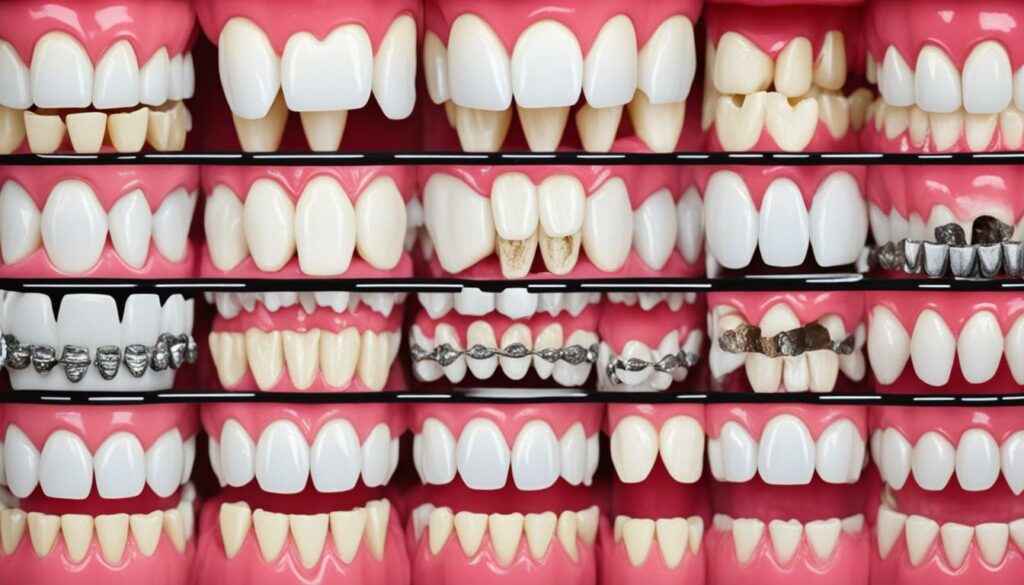
Some individuals may experience dental anomalies or variations, such as missing teeth or extra teeth. These dental anomalies can occur due to a variety of factors, including genetic predisposition, environmental factors, and developmental abnormalities.
Missing Teeth: One common dental anomaly is the absence of certain teeth, known as missing teeth or hypodontia. The most frequently affected teeth are the upper lateral incisors and wisdom teeth, although other teeth can also be affected. Missing teeth can be a hereditary condition and may require orthodontic treatment or dental prosthetics to restore proper dental function and aesthetics.
Extra Teeth: Conversely, some individuals may have additional teeth, known as supernumerary teeth or hyperdontia. These extra teeth can develop in various locations within the oral cavity and can cause issues such as overcrowding, misalignment, and difficulty maintaining oral hygiene. In such cases, orthodontic intervention or tooth extraction may be necessary to prevent complications and ensure proper dental development.
Dental anomalies and variations, whether missing teeth or supernumerary teeth, can have an impact on both physical and psychological aspects of an individual’s life. The condition may affect speech, chewing ability, smile aesthetics, and self-confidence. Therefore, it is important for individuals with dental anomalies to seek professional dental care to address the issue and explore appropriate treatment options.
In summary, dental anomalies such as missing teeth or extra teeth are not uncommon and can be caused by various factors. Seeking professional dental care and treatment is crucial for maintaining optimal oral health and overall well-being.
Let’s now take a closer look at the importance of proper dental care and hygiene for teens in Section 10.
Proper Dental Care and Hygiene
Proper dental care and hygiene are crucial for maintaining healthy teeth and gums. By following a consistent oral health care routine, you can keep your smile bright and protect against dental issues. Let’s explore some essential practices for optimal dental hygiene:
1. Brushing: Brush your teeth for two minutes at least twice a day using a soft-bristled toothbrush and fluoride toothpaste. Be sure to brush all surfaces of your teeth, including the outer, inner, and chewing surfaces. Pay extra attention to the gumline, where plaque tends to accumulate.
2. Flossing: Flossing is just as important as brushing, as it helps remove plaque and food particles from between your teeth and along the gumline. Use dental floss or interdental brushes to clean these hard-to-reach areas. Make flossing a daily habit to maintain optimal oral health.
3. Rinse: Use an antimicrobial mouthwash or a fluoride mouth rinse to help kill bacteria and strengthen your teeth. Swishing with mouthwash can reach areas that your toothbrush and floss might miss, providing an extra layer of protection against tooth decay and gum disease.
4. Maintain a Healthy Diet: Limit your intake of sugary and acidic foods and beverages, as they can contribute to tooth decay. Opt for a balanced diet rich in fruits, vegetables, lean proteins, and whole grains. These nutrient-rich foods support overall oral and systemic health.
5. Visit Your Dentist: Regular dental check-ups are essential for preventive care and early detection of dental issues. Schedule appointments with your dentist every six months for professional cleanings, oral examinations, and necessary treatments. Don’t wait until you have a problem; regular dental visits can save you time, money, and discomfort in the long run.
“Good dental hygiene leads to a healthy smile and a confident you!”
By incorporating these practices into your daily routine, you can maintain excellent dental hygiene and enjoy a lifetime of healthy teeth and gums.
| Morning Routine | Evening Routine | |
|---|---|---|
| Brushing | Brush your teeth for two minutes using a soft-bristled toothbrush and fluoride toothpaste. | Brush your teeth for two minutes using a soft-bristled toothbrush and fluoride toothpaste. |
| Flossing | Floss between your teeth and along the gumline to remove plaque and food particles. | |
| Mouthwash | Rinse with an antimicrobial mouthwash or fluoride mouth rinse for added protection. | Rinse with an antimicrobial mouthwash or fluoride mouth rinse for added protection. |
| Diet | Maintain a healthy diet, limiting sugary and acidic foods and beverages. | |
| Dental Check-ups | Visit your dentist every six months for professional cleanings and oral examinations. | |
Importance of Regular Dental Check-ups
Regular dental check-ups with a pediatric dentist are crucial for teens to maintain optimal oral health. These check-ups provide an opportunity to monitor dental health, ensure proper tooth development, and receive preventive treatments that can help prevent more serious issues down the line.
Dental professionals play a key role in identifying any dental issues early on, allowing for timely intervention and treatment. This can include dental cleanings to remove plaque and tartar buildup, fluoride treatments to strengthen teeth and prevent cavities, and orthodontic evaluations to address any alignment or bite issues.
By scheduling regular dental check-ups, teens can establish a strong foundation for lifelong oral health. These visits not only address immediate concerns but also serve as a proactive approach in preventing future dental problems.
One of the primary benefits of regular dental check-ups is early detection and prevention. Dental practitioners have the knowledge and expertise to identify early signs of dental issues such as cavities, gum disease, and malocclusion. By catching these problems early, treatment can be less invasive and more effective, saving teens from unnecessary pain and discomfort.
“Regular dental check-ups play a vital role in maintaining good oral health throughout teenage years and beyond. They allow dental professionals to detect and address any dental issues early on, ensuring proper tooth development and preventing more serious problems.”
In addition to early detection, preventive dental treatments are an integral part of regular check-ups. Dental professionals can provide guidance on proper oral hygiene practices, including brushing techniques, flossing, and mouth rinsing. They may also recommend the use of dental sealants to protect vulnerable areas of the teeth from decay.
Teens are particularly susceptible to dental issues due to factors such as poor dietary choices and hormonal changes. Regular check-ups help dental professionals monitor these factors and provide appropriate guidance to maintain optimal oral health. They can also identify any underlying issues that may require specialized care, such as orthodontic treatment.
| Benefits of Regular Dental Check-ups for Teens |
|---|
| Early detection and prevention of dental issues |
| Opportunity for dental professionals to monitor tooth development |
| Proactive approach to maintaining oral health |
| Guidance on proper oral hygiene practices |
| Possible recommendation of preventive treatments |
| Identification of underlying issues requiring specialized care |
By prioritizing regular dental check-ups, teens can take control of their oral health journey. These appointments empower them with knowledge, guidance, and professional care that can set them up for a lifetime of healthy smiles.
Conclusion
Understanding teen dental health and dental milestones is crucial for maintaining lifelong oral health. By practicing good dental care habits, such as regular brushing and flossing, and scheduling routine dental check-ups, teenagers can proactively take care of their teeth and gums.
Monitoring dental milestones, including the eruption of permanent teeth and the removal of wisdom teeth, ensures timely intervention if any issues arise. By addressing these milestones promptly, teens can avoid potential complications and maintain optimal oral health as they transition into adulthood.
Remember, oral health is not just about having a beautiful smile; it is an integral part of overall well-being. A healthy mouth contributes to better digestion, clear speech, and improved self-confidence. So, make teen dental health a priority and instill good dental habits early on for a lifetime of healthy smiles.
FAQ
How many teeth do teens have?
Teens typically have 32 permanent teeth, which include 8 incisors, 4 canines, 8 premolars, and 12 molars.
When does dental development begin in children?
Dental development in children begins with the eruption of baby teeth around 6 months of age.
How many baby teeth do kids have?
Kids have a total of 20 baby teeth, including 8 incisors, 4 canines, and 8 molars.
When do kids get their permanent teeth?
Kids start getting their permanent teeth around the age of 6 and continue until their late teens or early twenties.
What is the anatomy of teeth?
Each tooth is composed of three layers: enamel, dentin, and pulp.
What are the functions of different types of teeth?
Incisors are used for cutting food, canines are for tearing, premolars are for grinding and crushing, and molars are for tearing and chewing.
How should teens practice dental care?
Teens should practice good dental care habits, including brushing their teeth at least twice a day for two minutes and flossing daily.
When do wisdom teeth erupt?
Wisdom teeth, or third molars, typically erupt in the late teens to early twenties.
Do dental anomalies and variations exist?
Yes, some individuals may experience dental anomalies such as missing teeth or extra teeth.
What is the importance of proper dental care and hygiene?
Proper dental care and hygiene are essential for maintaining healthy teeth and gums throughout teenage years and beyond.
Why are regular dental check-ups important for teens?
Regular dental check-ups with a pediatric dentist are crucial for monitoring dental health, ensuring proper tooth development, and receiving preventive treatments.
How does dental care impact lifelong oral health?
Understanding dental milestones and addressing any issues promptly can help teens maintain a healthy smile and optimal oral health into adulthood.

